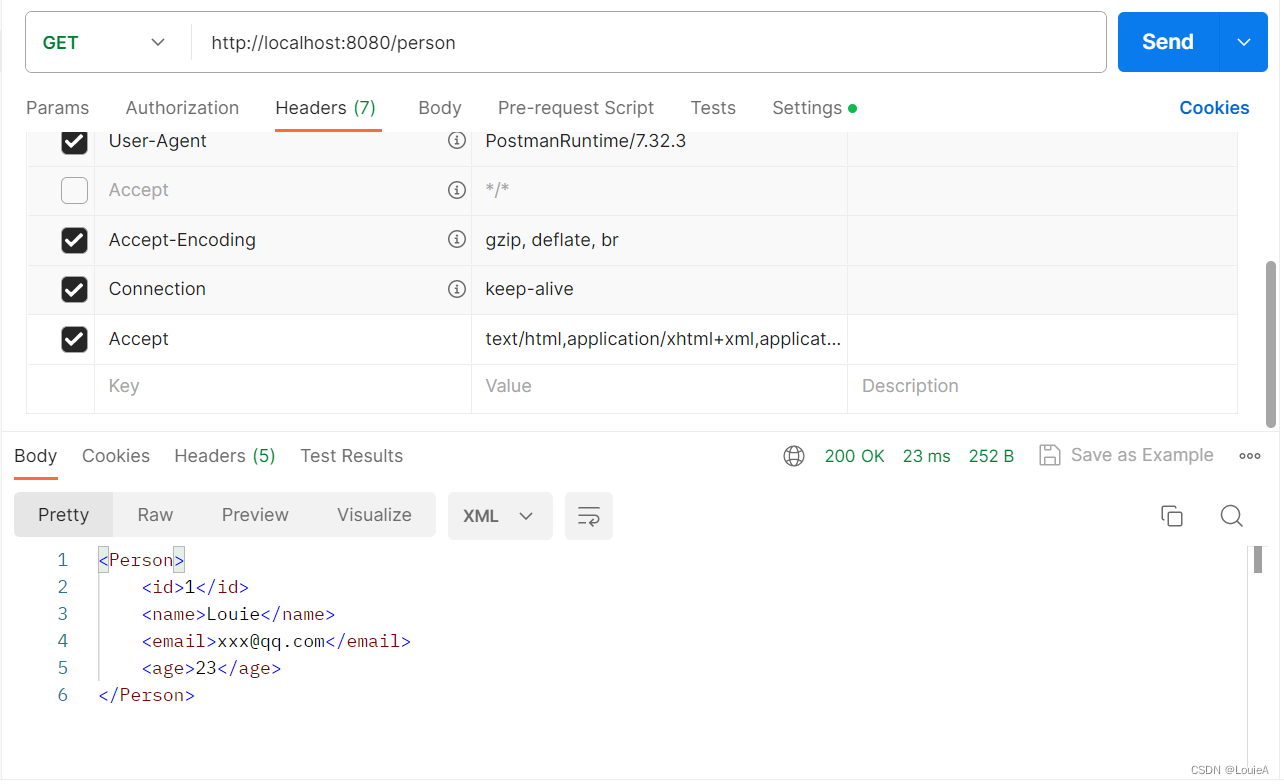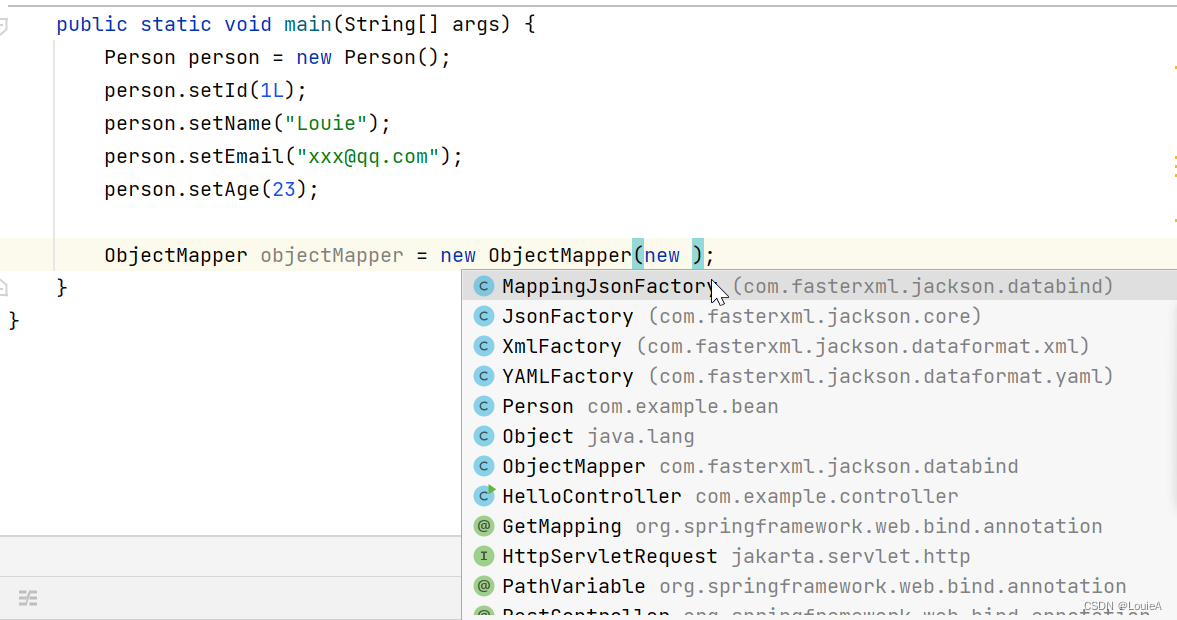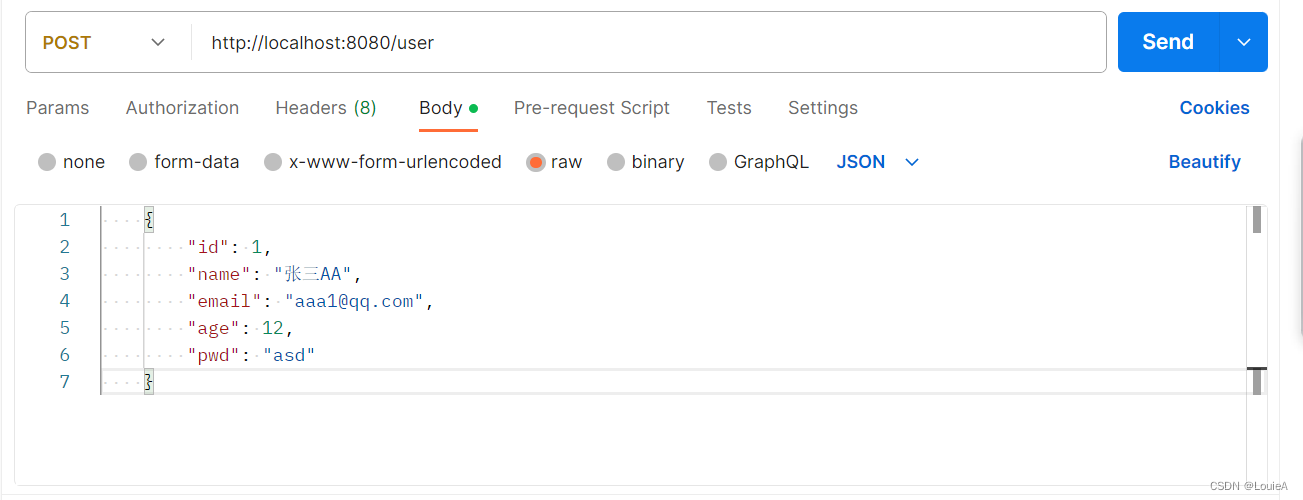SpringBoot3-Web开发
SpringBoot的Web开发能力,由SpringMVC提供。
Web开发的三种方式
| 方式 | 处理过程 | 注意事项 | 实现效果 |
|---|---|---|---|
| 全自动 | 直接编写控制逻辑 | 全部使用自动给配置默认效果 | |
| 手自一体 | @Configuration、 配置WebMvcConfigurer、 配置WebMvcRegistrations | 不要标注 @EnableWebMvc | 手动配置效果 手动设置部分功能 定义MVC底层组件 |
| 全手动 | @Configuration 配置WebMvcConfigurer | 标注@EnableWebMvc | 禁用自动配置效果 全手动设置 |
给容器中放一个配置类,使用
@Configuration标注,让配置类继承WebMvcConfigurer但是不要标注@EnableWebMvc注解,可以实现手自一体的效果。
1、Web场景
自动配置
①整合web场景
<dependency><groupId>org.springframework.boot</groupId><artifactId>spring-boot-starter-web</artifactId>
</dependency>②starter的spring-boot-starter引入了autoconfigure功能
③@EnableAutoConfiguration注解使用@Import(AutoConfigurationImportSelector.class)批量导入组件,加载"META-INF/spring/%s.imports"文件中配置的所有组件。

④在自动导入的配置类中绑定了配置文件的一堆配置项,比如:
-
SpringMVC的所有配置以
spring.mvc开头 -
Web场景通用的配置在
spring.web -
文件上传配置在
spring.servlet.multipart -
服务器的配置
server比如:编码方式
默认效果
默认配置
-
包含了
ContentNegotiatingViewResolver和BeanNameViewResolver组件,方便视图解析。 -
默认的静态资源处理机制:静态资源放在
static文件夹下即可直接访问。 -
自动注册了
Converter,GenericConverter,Formatter组件,适配常见的数据类型转换和格式化需求。 -
支持
HttpMessageConverters,可以方便返回json等数据类型。 -
注册
MessageCodesResolver,方便国际化及错误消息处理。 -
支持静态
index.html。 -
自动使用
ConfigurableWebBindingInitializer,实现消息处理、数据绑定、类型转换、数据校验等功能。
特别提示:
①如果想保持boot mvc的默认配置,并且自定义更多的mvc配置,如:interceptors,formatters, view controllers等,可以使用
@Configuration注解添加一个WebMvcConfigurer类型的配置类,但不要标注@EnableWebMvc。②如果想保持boot mvc的默认配置,但要自定义核心组件实例,比如
RequestMappingHandlerMapping,RequestMappingHandlerAdapter或ExceptionHandlerExceptioonResolver,给容器中放一个WebMvcRegistrations组件即可。③如果想全面接管Spring MVC,
@Configuration标注一个配置类,并加上@EnableWebMvc注解,实现WebMvcConfigurer接口。
2、静态资源
WebMvcAutoConfiguration
生效条件

效果
放入了两个filter
HiddenHttpMethodFilter:页面表单提交Rest请求(GET、POST、PUT、DELETE)
FormContentFilter:表单内容Filter,GET(数据放URL后面)、POST(数据放请求体)请求携带数据,但是PUT和DELETE的请求数据会被忽略,FormContentFilter是为了解决这个问题的。
@Bean
@ConditionalOnMissingBean(HiddenHttpMethodFilter.class)
@ConditionalOnProperty(prefix = "spring.mvc.hiddenmethod.filter", name = "enabled")
public OrderedHiddenHttpMethodFilter hiddenHttpMethodFilter() {return new OrderedHiddenHttpMethodFilter();
}
@Bean
@ConditionalOnMissingBean(FormContentFilter.class)
@ConditionalOnProperty(prefix = "spring.mvc.formcontent.filter", name = "enabled", matchIfMissing = true)
public OrderedFormContentFilter formContentFilter() {return new OrderedFormContentFilter();
}给容器中放入了
WebMvcConfigurer组件,给SpringMVC添加各种定制功能,所有的功能最终会和配置文件进行绑定
WebMvcProperties:以spring.mvc开头的配置文件
WebProperties:以spring.web开头的配置文件
@Configuration(proxyBeanMethods = false)
@Import(EnableWebMvcConfiguration.class)//额外导入了其他配置
@EnableConfigurationProperties({ WebMvcProperties.class, WebProperties.class })
@Order(0)
public static class WebMvcAutoConfigurationAdapter implements WebMvcConfigurer, ServletContextAware {
}WebMvcConfigurer接口
它提供配置SpringMVC底层的所有组件入口。

静态资源规则源码
@Override
public void addResourceHandlers(ResourceHandlerRegistry registry) {if (!this.resourceProperties.isAddMappings()) {logger.debug("Default resource handling disabled");return;}addResourceHandler(registry, this.mvcProperties.getWebjarsPathPattern(),"classpath:/META-INF/resources/webjars/");addResourceHandler(registry, this.mvcProperties.getStaticPathPattern(), (registration) -> {registration.addResourceLocations(this.resourceProperties.getStaticLocations());if (this.servletContext != null) {ServletContextResource resource = new ServletContextResource(this.servletContext, SERVLET_LOCATION);registration.addResourceLocations(resource);}});
}规则一
访问
/webjars/**路径就去classpath:/META-INF/resources/webjars/下找资源(查看依赖中的内容)
规则二
规则二:
访问
/**路径就去静态资源的四个默认位置下找资源classpath:/META-INF/resources/classpath:/resources/classpath:/static/classpath:/public/
registration.addResourceLocations(this.resourceProperties.getStaticLocations()
规则三
静态资源默认都有缓存规则的设置 i、cachePeriod:缓存周期(以s为单位),多久不再需要给服务器重新请求 ii、cacheControl:HTTP缓存控制 iii、useLastModified:是否使用最后一次修改。配合HTTP cache规则
浏览器访问了一个静态资源,如果这个服务没有发生变换,下次访问的时候可以直接让浏览器用自己缓存中的内容,而不用给服务器发请求。
registration.setCachePeriod(getSeconds(this.resourceProperties.getCache().getPeriod()));
registration.setCacheControl(this.resourceProperties.getCache().getCachecontrol().toHttpCacheControl());
registration.setUseLastModified(this.resourceProperties.getCache().isUseLastModified());EnableWebMvcConfiguration源码
属于WebMvcAutoConfiguration的一个内部类。
//SpringBoot 给容器中WebMvcConfigurationSupport组件
//如果我们自己放了WebMvcConfigurationSupport组件,Boot的WebMvcAutoConfiguration都会失效
@Configuration(proxyBeanMethods = false)
@EnableConfigurationProperties(WebProperties.class)
public static class EnableWebMvcConfiguration extends DelegatingWebMvcConfiguration implements ResourceLoaderAware {
}
HandlerMapping:根据请求路径,找哪个handler处理请求。
WelcomePageHandlerMapping:
-
问
/**路径下的所有请求都在以前四个静态资源路径下找,欢迎页也是。 -
找
index.html只要静态资源的位置有一个index.html页面,项目启动就默认访问。
在容器中加入WebMvcConfigurer就能配置底层行为的原因
-
WebMvcConfiguration是一个自动配置类,它里面有一个
EnableWebMvcConfiguration -
EnableWebMvcConfiguration继承于DelegatingWebMvcConfiguration,这两个都生效 -
DelegatingWebMvcConfiguration利用DI把容器中所有WebMvcConfiguration注入进来 -
别人调用
DelegatingWebMvcConfiguration的方法配置底层规则,而它调用所有WebMvcConfiguration的配置底层方法。
默认规则
①静态资源映射
静态资源映射规则在
WebMvcAutoConfiguration中进行了定义

-
/webjars/**的所有路径资源都在classpath:/META-INF/resources/webjars

-
/**的所有路径资源都在classpath:/META/resources/、classpath:/resources/、calsspath:/static/、calsspath:/public/ -
所有静态资源都定义了
缓存规则。浏览器访问过一次,就会缓存一段时间,但此功能参数无默认值-
period:缓存间隔。默认0s; -
cacheControl:缓存控制。默认无 -
useLastModified:是否使用lastModified头。默认是false
-
②静态资源缓存
如①所述所有静态资源都定义了缓存规则。浏览器访问过一次,就会缓存一段时间,但此功能参数无默认值
测试缓存机制
在calsspath/static下放置一个静态资源(图片)
配置application.properties
#1、spring.web:
# 配置国际化的区域信息
#配置静态资源策略(开启、处理链、缓存)
#开启静态资源映射规则
spring.web.resources.add-mappings=true
#设置缓存
spring.web.resources.cache.period=3600
#缓存详细合并项控制,覆盖period配置,
# 浏览器第一次请求服务器,服务器告诉浏览器此资源缓存7200秒,7200秒以内的所有此资源访问不用发给服务器请求
spring.web.resources.cache.cachecontrol.max-age=7200
#使用资源last-modified时间,来对此服务器和浏览器的资源是否相同,相同返回304
spring.web.resources.cache.use-last-modified=true
注意:
spring.web.resources.cache.period是用来设置静态资源在浏览器中的缓存过期时间。这个配置项告诉浏览器在多长时间内可以使用缓存的资源,而不需要向服务器发送请求。在这个例子中,缓存过期时间为1小时。
spring.web.resources.cache.cachecontrol.max-age是用来设置服务器告诉浏览器此资源的缓存时间。这个配置项告诉浏览器在多长时间内可以使用缓存的资源,而不需要向服务器发送请求。在这个例子中,服务器会告诉浏览器缓存时间为2小时。
自定义静态资源规则
自定义静态资源路径,自定义缓存规则
①配置application.properties方式
#2、spring.mvc
##2.1.自定义webjars路径前缀
spring.mvc.webjars-path-pattern=/webjars/**
##2.2.静态资源访问路径前缀
spring.mvc.static-path-pattern=/**
#静态资源的文件夹
spring.web.resources.static-locations=classpath:/a/, classpath:/b/spring.mvc:静态资源访问前缀路径
spring.web:静态资源目录、静态资源缓存策略
②代码方式
容器中只要有一个WebMvcConfigurer组件。配置的底层行为都会生效。
@Configuration//这是一个配置类
public class MyConfig implements WebMvcConfigurer {@Beanpublic WebMvcConfigurer webMvcConfigurer(){return new WebMvcConfigurer() {@Overridepublic void addResourceHandlers(ResourceHandlerRegistry registry) {//保留之前的配置WebMvcConfigurer.super.addResourceHandlers(registry);//自己添加一些registry.addResourceHandler("static/**").addResourceLocations("classpath:/static/", "classpath:/templates/").setCacheControl(CacheControl.maxAge(7200, TimeUnit.SECONDS));}};}
}
③欢迎页
欢迎页规则在WebMvcAutoConfiguration中进行了定义 a、在静态资源目录下找index.html b、没有就在templates下找index模板页
④Favicon
favicon.ico 通常显示在浏览器标签页。在这段代码中,在静态资源目录下寻找名为 favicon.ico 的文件。
3、路径匹配
Spring5.3之后加入了更多的
请求路径匹配的实现策略。以前只支持AntPathMatcher策略,现提供了PathPatternParser策略。并且可以让我们指定到底使用哪种策略。
①Ant风格路径语法
ant风格的路径模式语法具有以下规则:
| 规则 | 含义 |
|---|---|
| * | 表示任意的0个或多个字符 |
| ? | 表示任意一个字符 |
| ** | 表示任意数量的目录 |
| {} | 表示一个命名的模式占位符 |
| [] | 表示字符集合,例如[a-z]表示小写字母 |
示例:
*.html:匹配任意名称,扩展名为.html的文件 /folder1/*/*.java:匹配在folder1目录下的任意两级目录下的.java文件 /folder2/**/*.jsp:匹配在folder2目录下任意目录深度的.jsp文件 /{type}/{id}.html:匹配任意文件名为{id}.html,在任意命名的{type}目录下的文件
注意: Ant风格的路径模式语法中的特殊特殊字符需要转义,如: 要匹配文件路径中的星号,则需要转义为\* 要匹配文件路径中的问好,则需要转义为\?
②模式切换
AntPathMatcher与PathPatternParser是Spring框架中用于处理路径模式匹配的工具类。 PathPatternParser在jmh基准测试下,有6~8被吞吐量提升,降低30%~40%的空间分配率 PathPatternParser兼容AntPathMatcher语法,并支持更多类型的路径模式 PathPatternParser"**"多端匹配的支持仅允许在模式末尾使用@Slf4j
@RestController
public class HelloController {/*** springBoot默认使用新版的路径匹配(PathPatternParser)不能匹配双星在中间的情况,剩下的和AntPathMatcher使用方法相同可以在配置文件中使用:spring.mvc.pathmatch.matching-strategy=ant_path_matcher改为老版策略* @param request* @param path* @return*/@GetMapping("/a*/b?/{p1:[a-f]+}/**")public String hello(HttpServletRequest request, @PathVariable("p1") String path){log.info("路径变量p1:{}", path);String url = request.getRequestURI();return url;}
}
总结: 使用默认的路径匹配规则,是由
PathPatternParser提供的 如果路径中间出现问题需要有**,替换成Ant风格路径。
4、内容协商
一套系统适配多端数据返回。

①多端内容适配
-
默认规则
-
基于请求头的内容协商(默认开启)
客户端向服务端发送请求,携带HTTP标准的Accept请求头
Accept:application/json、text/xml、text/yml服务端根据客户端请求头期望的数据类型进行动态返回。 -
基于请求参数内容协商(需要手动开启)
a、发送请求
GET/projects/spring-boot?format=jsonb、匹配到@GetMapping("/projects/spring-boot")c、根据参数协商,优先返回json类型数据(需要开启参数匹配设置) d、发送请求GET/projects/spring-boot?format=xml,优先返回xml类型数据。
-
效果演示
场景:
请求同一个接口,可以返回json和xml不同格式的数据,使用官方Postman进行测试。

实体类(Person)
@Data
@NoArgsConstructor
@AllArgsConstructor
public class Person {private Long id;private String name;private String email;private Integer age;
}Controller
返回JSON格式
@Slf4j
@RestController
public class HelloController {/*** json适配,默认支持把对象转化为json,web场景默默人导入了jackson处理json的包;jackson-core* jackson也支持把数据转化为xml。但需要导入xml相关依赖* @return*/@GetMapping("/person")public Person person(){Person person = new Person();person.setId(1L);person.setName("Louie");person.setEmail("xxx@qq.com");person.setAge(23);return person;}
}
返回XML格式
①引入支持xml内容的依赖
<dependency><groupId>com.fasterxml.jackson.dataformat</groupId><artifactId>jackson-dataformat-xml</artifactId>
</dependency>②实体类中标注注解
@JacksonXmlRootElement//可以写出为xml文档
@Data
@NoArgsConstructor
@AllArgsConstructor
public class Person {private Long id;private String name;private String email;private Integer age;
}
注意:
在浏览器中不能正常显示,可以将浏览器的Accept复制在Postman中新加一个Accept,关闭原来的Accept
-
配置协商规则与支持类型
-
修改内容协商方式
#开启基于请求参数的内容协商功能。默认参数名是format spring.mvc.contentnegotiation.favor-parameter=true #自定义参数名,默认为format spring.mvc.contentnegotiation.parameter-name=myParam -
效果
-


②内容协商原理-HttpMessageConverter
熟悉
HttpMessageConverter怎么工作,何时工作,就可以定制HttpMessageConverter来实现多端内容协商。
实现
编写
WebMvcConfigurer提供的configureMessageConverters底层,修改底层的MessageConverter
@ResponseBody由HttpMessageConverter处理,标注了@ResponseBody的返回值将会由支持它的HttpMessageConverter写给浏览器。
原理
a、controller方法的返回值标注了@ResponseBody注解
b、请求进来先来到DispartureServlet的doDispatch()进行处理
c、找到HandlerAdapter适配器
d、利用适配器执行目标方法RequestMappingHandlerAdapter来执行
e、调用involeHandlerMethod执行目标方法。目标方法执行之前,HandlerMethodArgumentResolver(参数解析器)确定目标方法每一个参数值。HandlerMethodReturnValueHandler(返回值处理器)确定目标方法的返回值该增么处理。
f、incokeAndHandle()真正执行目标方法。目标方法执行完成,会导出返回值对象。
g、找到一个合适的返回值处理器HandlerMethodReturnValueHandler
h、最终找到RequestResponseBodyMethodProcessor能处理标注了@RsponseBody注解的方法
i、RequestResponseBodyMethodProcessor调用writerWithMessageConverters,利用MessageConverter把返回值写出去。
总结:
@ResponseBody由HttpMessageConverter处理,HttpMessageConverter会先进行内容协商。WebMvcAutoConfiguration通过addDefaultHttpMessageConverters添加了默认的MessageConverter如下:ByteArrayHttpMessageConverter:支持字节数据读取StringHttpMessageConverter:支持字符串读写ResourceHttpMessageConverter:支持资源读写ResourceRegionHttpMessageConverter:支持分区资源写出AllEncompassingFormHttpMessageConverter:支持表单xml/json读写MappingJackson2HttpMessageConverter:支持请求响应Json读写遍历所有的
MessageConverter看谁支持这种内容类型的数据,将支持的类型写出。 系统默认的MessageConverter功能有限,仅用于json或普通返回数据。额外增加新的内容协商功能,必须增加新的HttpMessageConverter。
③WebMvcConfigurationSupport
该类提供了很多的默认设置。判断系统中是否有相应的类,如果有,就加入相应的HttpMessageConverter

jackson2Present = ClassUtils.isPresent("com.fasterxml.jackson.databind.ObjectMapper", classLoader) &&ClassUtils.isPresent("com.fasterxml.jackson.core.JsonGenerator", classLoader);jackson2XmlPresent = ClassUtils.isPresent("com.fasterxml.jackson.dataformat.xml.XmlMapper", classLoader);jackson2SmilePresent = ClassUtils.isPresent("com.fasterxml.jackson.dataformat.smile.SmileFactory", classLoader);jackson2CborPresent = ClassUtils.isPresent("com.fasterxml.jackson.dataformat.cbor.CBORFactory", classLoader);④自定义内容返回
场景:增加yaml返回支持
步骤
-
导入依赖
<dependency><groupId>com.fasterxml.jackson.dataformat</groupId><artifactId>jackson-dataformat-yaml</artifactId>
</dependency>-
把对象写出成一个yaml
@Slf4j
@RestController
public class HelloController {public static void main(String[] args) throws JsonProcessingException {Person person = new Person();person.setId(1L);person.setName("Louie");person.setEmail("xxx@qq.com");person.setAge(23);
// new YAMLFactory().disable(YAMLGenerator.Feature.WRITE_DOC_START_MARKER);可以去掉三个横线ObjectMapper mapper = new ObjectMapper(new YAMLFactory());String s = mapper.writeValueAsString(person);System.out.println(s);}
}

-
编写配置
#增加一种新的内容类型
spring.mvc.contentnegotiation.media-types.yaml=text/yaml-
MyYamlHttpMessageConverter
增加HttpMessageConverter组件,专门负责把对象写出为yaml格式
public class MyYamlHttpMessageConverter extends AbstractHttpMessageConverter<Object> {private ObjectMapper objectMapper = null;//实例化public MyYamlHttpMessageConverter(){//告诉SpringBoot这个MessageConverter支持哪种媒体类型super(new MediaType("text", "yaml", Charset.forName("UTF-8")));//把对象转化为yamlthis.objectMapper = new ObjectMapper(new YAMLFactory());}@Overrideprotected boolean supports(Class<?> clazz) {//只要是对象类型,不是基本类型return true;}@Override//@RequestBodyprotected Object readInternal(Class<?> clazz, HttpInputMessage inputMessage) throws IOException, HttpMessageNotReadableException {return null;}@Override//@ResponseBody 把对象怎么写出去protected void writeInternal(Object methodReturnValue, HttpOutputMessage outputMessage) throws IOException, HttpMessageNotWritableException {//try-with写法,自动关流try(OutputStream os = outputMessage.getBody()){this.objectMapper.writeValue(os, methodReturnValue);}}
}-
编写配置类
@Configuration//这是一个配置类
public class MyConfig implements WebMvcConfigurer {@Beanpublic WebMvcConfigurer webMvcConfigurer(){return new WebMvcConfigurer() {@Override//配置一个能把对象转为yaml的messageConverterpublic void configureMessageConverters(List<HttpMessageConverter<?>> converters) {WebMvcConfigurer.super.configureMessageConverters(converters);converters.add(new MyYamlHttpMessageConverter());}};}
}
总结:
1、配置媒体类型支持
spring.mvc.contentnegotiation.media-types.yaml=text/yaml2、编写对应的HttpMessageConverter,告诉Boot这个支持的媒体类型 3、把MessageConverter组件加入到底层。(容器中放一个
WebMvcConfigurer组件,并配置底层的MessageConverter)
5、模板引擎
由于SpringBoot使用了嵌入式Servlet容器,所以JSP默认不能使用,如果需要服务端页面渲染,优先考虑使用模板引擎。

SpringBoot模板引擎的自动配置包括:FreeMarker、Groovy、Thymeleaf、Mustache
Thymeleaf整合
Thymeleaf官网
基础语法
①核心用法
th:xxx动态渲染指定的html标签属性值、或者th指令(遍历、判断等) th:text:标签体内文本值渲染
<h3 th:text="${msg}">哈哈</h3>
<!--th:text:替换标签体的内容-->
<h3 th:utext="${msg}">呵呵</h3>
<!--th:utext:不会转义html标签,显示html该有的样式-->th:属性:标签指定属性渲染
<img th:src="${url}"/>
<!--访问动态路径-->th:attr:标签任意属性渲染
<img src="picture.jpg" style="width: 300px" th:attr="src=${url}, style=${modelStyle}"/>
<!--访问动态路径, 和动态的样式-->th:if、th:each...:其他th指令
<img src="${url}" th:if="${show}"/>
<!--访问动态路径, 并且由控制器传入的show来判断它是否显示-->表达式:用来动态取值
${}:变量取值,使用model共享给页面的值都直接用${} @{}:url路径 #{}:国际化消息 ~{}:片段引用 *{}:变量选择(需要配合th:object绑定对象)
系统工具和内置对象可以查看详细文档。
param:请求参数对象
<p>参数是否存在: ${param.containsKey('parameterName')}</p>session:session对象
<p>Session属性: ${session.getAttribute('attributeName')}</p>application:application对象
<p>Application属性: ${application.getAttribute('attributeName')}</p>#execInfo:模板执行信息
<p>模板名称: ${#execInfo.templateName}</p>
<p>模板行号: ${#execInfo.templateLine}</p>#messages:国际化消息
<p>国际化消息: #{messageKey}</p>#uris:uri/url工具
<a href="${#uris.encodeUrl('/path')}">链接</a>#conversions:类型转换工具
<p>转换为数字: ${#conversions.stringToNumber('10')}</p>#dates:日期工具,是java.util.Date对象的工具类
<p>当前日期: ${#dates.format(#dates.createNow(), 'yyyy-MM-dd')}</p>#calendars:类似dates,只不过是java.util.calendar对象的工具类
#temporals:JDK8+java.time API工具类
#numbers:数字操作工具
#strings:字符串操作
#objects:对象操作
#bools:bool操作
#arrays:array工具
#lists:list工具
#sets:set工具
#maps:map工具
#aggrregates:集合聚合工具(sum、avg)
#ids:id生成工具
②语法示例
-
表达式
-
变量取值:${...}
-
url取值:@{...}
-
国际化消息:#{}
-
变量选择:*{...}
-
片段引用:~{...}
-
-
文本操作
-
拼串:+
-
文本替换:|The name is ${name|
-
-
布尔操作
-
二进制运算:and、or
-
取反:!、not
-
-
比较运算
-
比较:>、<、<=、>=(gt,lt,ge,le)
-
等值运算:==、!=(eq、ne)
-
-
条件运算
-
if-then:(if)?(then)
-
if-then-else:(if)?(then):(else)
-
default:(value)?:(defaultValue)
-
-
特殊语法
-
无操作:_
-
示例
属性设置
①th:href="@{/product/list}" ②th:attr="calss=${active}" ③th:attr="src=@{/images/gtvglogo.peng},title=${logo}, alt=#{logo}" ④th:checked="${user:active}"

遍历
语法:th:each="元素名, 迭代状态:${集合}"

迭代状态(iterStat)包含下面的属性: index:当前遍历元素的索引,从0开始 count:当前遍历元素的索引,从1开始 size:需要遍历元素的总数量 current:当前正在遍历的元素对象 event/odd:是否偶数/奇数行 first:是否第一个元素 last:是否最后一个元素
使用方式
导入场景
<dependency><groupId>org.springframework.boot</groupId><artifactId>spring-boot-starter-thymeleaf</artifactId>
</dependency>实体类Person
@Data
@NoArgsConstructor
@AllArgsConstructor
public class Person {private Long id;private String name;private String email;private Integer age;private String pwd;
}编写测试页面
list.html
<!DOCTYPE html>
<html lang="en">
<head><meta charset="UTF-8" xmlns:th="http://www.thymeleaf.org"><title>person列表页</title>
</head><body>
<table border="1px" cellpadding="0" ><tr><th>#</th><th>名字</th><th>邮箱</th><th>年龄</th><th>密码</th><th>状态信息</th></tr><tr th:each="person, status:${persons}"><td></td><td th:text="${person.name}"></td><td>[[${person.email}]]</td><td th:text="${person.age}"></td><td th:text="${person.pwd}"></td><td>index: [[${status.index}]]<br/>count:[[${status.count}]]<br/>size: [[${status.size}]]<br/>current(当前对象): [[${status.current}]]<br/>even: [[${status.even}]]<br/>odd: [[${status.odd}]]<br/>first: [[${status.first}]]<br/>last: [[${status.last}]]<br/></td></tr>
</table>
</body>
</html>controller
@GetMapping("/list")
public String list(Model model){List<Person> person = Arrays.asList(new Person(1L, "张三01", "aaa1@qq.com", 12, "asd"),new Person(2L, "张三02", "aaa2@qq.com", 18, "akd"),new Person(3L, "张三03", "aaa3@qq.com", 19, "ajd"),new Person(4L, "张三04", "aaa4@qq.com", 22, "aad"),new Person(5L, "张三05", "aaa5@qq.com", 23, "afd"),new Person(6L, "张三06", "aaa6@qq.com", 23, "abd"));model.addAttribute("persons", person);return "list";
}
判断th:if
<td th:text="|${person.age} / ${person.age>=18?'成年':'未成年'}|"></td>
<td th:if="${#strings.isEmpty(person.email)}" th:text="'已失联'"></td>
<!--删除两-->
<td th:if="${not #strings.isEmpty(person.email)}" th:text="${person.email}"></td>
th:switch

属性优先级
| 优先级 | 特点 | 属性 |
|---|---|---|
| 1 | 片段包含 | th:insert th:replace |
| 2 | 遍历 | th:each |
| 3 | 判断 | th:if th:unless th:switch th:case |
| 4 | 定义本地变量 | th:object th:with |
| 5 | 通用方式属性修改 | th:attr th:attrprepend th:attrappend |
| 6 | 指定属性修改 | th:value th:href th:src |
| 7 | 文本值 | th:text th:utext |
| 8 | 片段指定 | th:fragment |
| 9 | 片段移除 | th:remove |
注意:
在行内使用的时候,可以有如下的两种写法:
[[...]]或[(...)]
#如
size: [[${status.size}]]<br/>
变量选择


模板布局
将通用的内容抽取出来。
| 属性 | 含义 |
|---|---|
| th:fragment | 定义模板 |
| ~{templatename::selector}(~{模板名 :: 片段名}) | 引用模板 |
| th:insert、th:replace | 插入模板 |

footer表示公共页面的名称。
自动配置原理
①开启了org.springframework.boot.autoconfigure.thymeleaf.ThymeleafAutoConfiguration自动配置 ②属性绑定在ThymeleafProperties中,对应配置文件前缀spring.thymeleaf内容 ③所有的模板页面默认在classpath:/templates文件夹下 ④默认效果 a、所有的模板页面在classpath:/templates下面找 b、后缀名为.html
devtools
SpringBoot提供的工具,在修改页面后。在IDEA中ctrl+F9重新编译。
使用方式
方式一
<!--热启动功能-->
<dependency><groupId>org.springframework.boot</groupId><artifactId>spring-boot-devtools</artifactId>
</dependency>java代码的修改,如果使用devtools热启动了,可能会引起一些BUG,建议使用重启。
方式二
也可以在setting的Compiler中勾选Build project automatically,然后点击ctrl + alt + shift + /打开Register,勾选其中的compiler.automake.allow.when.app.running。(当idea失去焦点5秒时自动构建。不用一直点)


热部署范围配置
默认不触发重启的目录列表
/META-INF/maven /META-INF/resource /resources /static /public /templates
可以通过修改配置文件的方式修改这个范围。
spring:devtools:restart:exclude: static/**, public/**, config/application.yaml关闭热启动的功能
可以在application.yaml中设置enabled=false,但可能存在的情况是其他配置文件相同内容的覆盖,所以可在主程序中设置
public static void main(String[] args) {System.setProperty("spring.devtools.restart.enabled", "false");SpringApplication.run(SSMPApplication.class, args);
}6、国际化
国际化的自动配置参照
MessageSourceAutoConfiguration
实现步骤
-
SpringBoot在类路径下查找message资源绑定文件。文件名为:
messages.properties -
多语言可以定义多个消息文件,命名为message_区域代码.properties。如:
-
messages.properties:默认 -
messages_en_US.properties:英文环境 -
messages_zh_CN.properties:中文环境
-
在程序中可以自动注入Message组件,获取国际化的配置项值
-
在页面中可以使用表达式#{}获取国际化的配置选项
实现方式
配置文件方式
配置文件
messages.properties
login=Login
sign=Sign-Upmessages_en_US.properties
login=Login
sign=Sign-Upmessages_zh_CN.properties
login=登录
sign=注册展示页面earth.html
<!DOCTYPE html>
<html lang="en">
<head><meta charset="UTF-8" xmlns:th="http://www.thymeleaf.org"><title>Title</title>
</head>
<body>
<!--国际化:配置页面的值去哪个文件取到key-->
<div><button th:text="#{login}"></button><button th:text="#{sign}"></button>
</div>
</body>
</html>controller
@GetMapping("/internationalize")
public String test(){return "earth";
}




代码方式
需要使用@RestController
@Autowired//国际化取消息用的组件
MessageSource messageSource;
@GetMapping("/haha")
public String haha(HttpServletRequest req){Locale locale = req.getLocale();//利用代码的方式获取国际化配置文件中指定的值String login = messageSource.getMessage("login", null, locale);return login;
}

7、错误处理
错误处理的自动配置都在
ErrorMvcAutoConfiguration中,有两大核心机制 1、SpringBoot会自动适应处理错误(你设置的format是什么它就可以给你响应什么数据),响应页面或JSON数据 2、SpringMvc的错误处理机制依然保留,MVC处理不了,才会交给boot进行处理。
测试
@ExceptionHandler
@Controller
public class ExceptionController {@GetMapping("/exception")public String testException(){int i = 10 / 0;return "index";}
/*** 1、@ExceptionHandler标识一个方法处理错误,默认只能处理这个类发生的的指定错误* 2、@ControllerAdvice统一处理所有错误* @param e* @return*/@ResponseBody@ExceptionHandler(Exception.class)public String handlerException(Exception e){return "OHH~, 错误原因:" + e.getMessage();}
}
@ControllerAdvice
控制器
@Controller
public class ExceptionController {@GetMapping("/exception")public String testException(){int i = 10 / 0;return "index";}
}handler
@ControllerAdvice
public class GlobalExceptionHandler {/*** 1、@ExceptionHandler标识一个方法处理错误,默认只能处理这个类发生的的指定错误* 2、@ControllerAdvice统一处理所有错误* @param e* @return*/@ResponseBody@ExceptionHandler(Exception.class)public String handlerException(Exception e){return "OHH~同一处理, 错误原因:" + e.getMessage();}
}
错误处理类(BasicErrorController)

表示它从server.error.path读取配置文件,如果没有配置就会读取/error
-
发生错误以后,转发给/error路径,SpringBoot在底层写好一个BasicErrorController的组件,专门处理这个请求。

-
错误页面解析方式
//1、解析错误的视图地址
ModelAndView modelAndView = resolveErrorView(request, response, status, model);
//2、如果解析不到错误页面的地址,默认的错误页就是error页
return (modelAndView != null) ? modelAndView : new ModelAndView("error", model);容器中专门有一个错误视图解析器(在ErrorMvcAutoConfiguration)
@Bean
@ConditionalOnBean(DispatcherServlet.class)
@ConditionalOnMissingBean(ErrorViewResolver.class)
DefaultErrorViewResolver conventionErrorViewResolver() {return new DefaultErrorViewResolver(this.applicationContext, this.resources);
}DefaultErrorViewResolver
@Override
public ModelAndView resolveErrorView(HttpServletRequest request, HttpStatus status, Map<String, Object> model) {ModelAndView modelAndView = resolve(String.valueOf(status.value()), model);if (modelAndView == null && SERIES_VIEWS.containsKey(status.series())) {modelAndView = resolve(SERIES_VIEWS.get(status.series()), model);}return modelAndView;
}
private ModelAndView resolve(String viewName, Map<String, Object> model) {String errorViewName = "error/" + viewName;TemplateAvailabilityProvider provider = this.templateAvailabilityProviders.getProvider(errorViewName,this.applicationContext);if (provider != null) {return new ModelAndView(errorViewName, model);}return resolveResource(errorViewName, model);
}
private ModelAndView resolveResource(String viewName, Map<String, Object> model) {for (String location : this.resources.getStaticLocations()) {try {Resource resource = this.applicationContext.getResource(location);resource = resource.createRelative(viewName + ".html");if (resource.exists()) {return new ModelAndView(new HtmlResourceView(resource), model);}}catch (Exception ex) {}}return null;
}容器中有一个默认的名为error的view;提供了默认白页功能。
@Bean(name = "error")
@ConditionalOnMissingBean(name = "error")
public View defaultErrorView() {return this.defaultErrorView;
}规则:
-
解析一个错误页
-
如果发生了5xx,4xx ①、如果有模板引擎,默认会在
classpath:/templates/error/精确码.html②、如果没有模板引擎,在静态资源文件夹下找精确码.html(模糊匹配) -
如果匹配不到
精确码.html,有模板引擎就去找classpath:/templates/error/5xx/4xx.html,没有模板引擎,在静态资源文件夹下找5xx.html,4xx.html。
-
如果模板引擎路径下面有
error.html页面,就直接渲染。
测试
templates下error
<!DOCTYPE html>
<html lang="en">
<head><meta charset="UTF-8" xmlns:th="http://www.thymeleaf.org"><title>error</title>
</head>
<body>
模板引擎 ERROR
</body>
</html>
-
最佳处理错误方式
-
前后端分离
后台发生的所有错误,使用
@ControllerAdvice+@ExceptionHandler进行异常处理
-
服务端页面渲染 - HTTP状态码规定错误 给
classpath:/templates/error/放入常用精确的错误码页面,500.html/404.html给classpath:/templates/error/放通用模糊匹配的错误页面。4xx.html/5xx.html- 业务错误 核心业务,每种错误都因该代码控制跳转到定制错误页面。 通用业务,在classpath:/templates/error.html页面显示错误信息。(出现的错误信息通过SpringBoot都将它们放在了ModelAndView,只需要通过Thymeleaf方式取值即可)
8、嵌入式容器
Servlet容器:管理,运行Servlet组件(Servlet,Filter, Listener)的环境,一般值服务器。
自动配置原理
SpringBoot默认嵌入了Tomcat作为Servlet容器。自动配置类是
ServletWebServerFactoryAutoConfiguration,EnbeddedWenServerFactoryCustomizerAutoConfiguration
@AutoConfiguration(after = SslAutoConfiguration.class)
@AutoConfigureOrder(Ordered.HIGHEST_PRECEDENCE)
@ConditionalOnClass(ServletRequest.class)
@ConditionalOnWebApplication(type = Type.SERVLET)
@EnableConfigurationProperties(ServerProperties.class)
@Import({ ServletWebServerFactoryAutoConfiguration.BeanPostProcessorsRegistrar.class,ServletWebServerFactoryConfiguration.EmbeddedTomcat.class,ServletWebServerFactoryConfiguration.EmbeddedJetty.class,ServletWebServerFactoryConfiguration.EmbeddedUndertow.class })
public class ServletWebServerFactoryAutoConfiguration {
}a、ServletWebServerFactoryAutoConfiguration配置类,绑定了所有和服务器有关的配置server b、绑定了自动配置类嵌入式容器场景。 c、ServletWebServerFactoryAutoConfiguration导入了嵌入式的三大服务器Tomcat、Jetty、Undertow i、导入Tomcat、Jetty、Undertow都有条件注解,系统中有这个类才行(相关依赖) ii、默认Tomcat配置生效 iii、它们都给容器中ServletWebServerFactory放了一个web服务器工厂(造web服务器) iV、web服务器工厂都有一个功能,getWebServer获取web服务器 d、ServletWebServerApplicationContextioc容器,启动的时候会调用(createWebServer)创建web服务器,而createWebServer会在onRefresh启动。(Spring容器刷新的时候,会预留一个时机,刷新子容器。onRefresh)
总结:
Web场景的Spring容器启动,在onRefresh的时候会调用Web服务器的方法。 Web服务器的创建是通过WebServerFactory实现,容器中又会根据导入的依赖的条件注解启动相关服务器。
用法
修改server下的相关配置即可修改服务器参数,通过给容其中放入一个
ServletWebServerFactory来禁用SpringBoot默认放的工厂,实现自定义嵌入任意服务器。
9、全面接管SpringMVC
SpringBoot默认配置好了SpringMVC的所有常用特性,如果我么需要全面接管SpringMVC的所有配置并禁用默认配置,仅需要编写一个WebMvcConfigurer配置类,并标注
@EnableWebMvc即可。 全手动模式:@EnableWebMvc:禁用默认设置WebMvcConfigurer组件:定义MVC的底层行为
@EnableWebMvc原理
①WebMvcAutoConfiguration:web场景的自动配置类。
SpringMVC自动场景配置了如下所有的默认行为 a、支持RESTful的filter:HiddenHttpMethodFilter b、支持非POST请求,请求体携带数据:FormContentFilter c、导入了@Import(EnableWebMvcConfiguration): i、WelcomePageHandlerMapping:欢迎页功能支持(模板引擎目录,金泰资源目录放index.html),项目访问/就默认展示这个页面 ii、LocaleResolver:国际化解析器 iii、ThemeResolver:主题解析器 iv、FlashMapManager:临时数据共享 v、FormattingConversionService:数据格式化、类型转化 vi、Validator:数据校验JSR303提供的数据校验功能 vii、RequestMappingHandlerMapping找每个请求由谁处理的映射关系 viii、WebBindingInitializer:请求参数的封装与绑定 ix、ExceptionHandlerExceptionResolver:默认的异常解析器 x、ContentNegotiationManager:内容协商管理器
d、WebMvcAutoConfigurationAdapter配置生效,它是一个WebMvcConfigurer,定义mvc底层组件 i、定义好WebMvcConfigurer底层组件的默认功能 ii、视图解析器:InternalResourceViewResolver iii、视图解析器:BeanNameViewResolver,视图名(controller方法返回值字符串)就是组件名 iV、内容协商解析器:ContentNegotiatingViewResolver v、请求上下文的过滤器:RequestContextFilter:任意位置直接获取当前请求(RequestContextHolder) vi、静态资源链规则 vii、ProblemDetailsExceptionHandler:错误详情 e、定义了默认的底层行为:WebMvcConfigurer
②@EnableWebMvc禁用默认行为
a、给容器中导入DelegatingWebMvcConfiguration组件,它是WebMvcConfigurationSupport b、WebMvcAutoConfiguration有一个核心的注解@ConditionalOnMissingBean(WebMvcConfigurationSupport.class),容器中没有WebMvcConfigurationSupport,WebMvcAutoConfiguration才生效 c、@EnableWebMvc导入WebMvcConfigurationSupport导致WebMvcAutoConfiguration失效。导致禁用了。
10、Web新特性
Problemdetails
它是
RFC 7807定义的规范,用于定义错误信息返回格式。
文档:RFC 7807: Problem Details for HTTP APIs
原理
@Configuration(proxyBeanMethods = false)
//配置过一个属性spring.mvc.problemdetails.enabled=true
@ConditionalOnProperty(prefix = "spring.mvc.problemdetails", name = "enabled", havingValue = "true")
static class ProblemDetailsErrorHandlingConfiguration {
@Bean@ConditionalOnMissingBean(ResponseEntityExceptionHandler.class)ProblemDetailsExceptionHandler problemDetailsExceptionHandler() {return new ProblemDetailsExceptionHandler();}
}a、
ProblemDetailsExceptionHandler是一个@ControllerAdvice集中处理系统异常 b、处理以下指定异常,如果系统出现以下异常,会被SpringBoot支持RFC 7807的方式返回异常
@ExceptionHandler({HttpRequestMethodNotSupportedException.class,HttpMediaTypeNotSupportedException.class,HttpMediaTypeNotAcceptableException.class,MissingPathVariableException.class,MissingServletRequestParameterException.class,MissingServletRequestPartException.class,ServletRequestBindingException.class,MethodArgumentNotValidException.class,NoHandlerFoundException.class,AsyncRequestTimeoutException.class,ErrorResponseException.class,ConversionNotSupportedException.class,TypeMismatchException.class,HttpMessageNotReadableException.class,HttpMessageNotWritableException.class,BindException.class})函数式web
SpringMVC5.2之后允许我们使用函数式的方式,定义web的请求处理流程。
Web请求处理的方式: a、@Controller + @RequestMapping:耦合式(路由、业务耦合) b、函数式Web:分离式(路由、业务分离)
使用场景实例:
场景 User RESTful-CRUD GET/user/1 获取1号用户 GET/user 获取所有用户 POST/user 请求体携带JSON,新增一个用户 PUT/user/1 请求体携带JSON,修改1号用户 DELETE/user/1删除1号用户
实现步骤
核心类 RouterFunction RequestPredicate ServerRequest ServerResponse
①实体类User
@Data
@NoArgsConstructor
@AllArgsConstructor
public class User {private Long id;private String name;private String email;private Integer age;private String pwd;
}②编写路由请求WebFunctionConfig
package com.louis.config;
import com.louis.business.UserBusinessHandler;
import org.springframework.context.annotation.Bean;
import org.springframework.context.annotation.Configuration;
import org.springframework.http.MediaType;
import org.springframework.web.servlet.function.*;
/*** @author XRY* @date 2023年07月13日15:15*/
/*** GET/user/1 获取1号用户* GET/user 获取所有用户* POST/user 请求体携带JSON,新增一个用户* PUT/user/1 请求体携带JSON,修改1号用户* DELETE/user/1 删除1号用户*/
@Configuration
public class WebFunctionConfig {/*** 函数式web* 1、给容器中放一个Bean RouterFunction<ServerResponse>* 2、每个业务准备一个自己的handler,但它的声明需要使用HandlerFunction类型** 函数式web核心四大对象* 1、RouterFunction:定义路由信息。发什么请求、谁来处理* 2、RequestPredicate:请求谓语。请求方式(Get、POST)、请求参数* 3、ServerRequest:封装请求完整数据* 4、ServerResponse:封装响应完整数据*//* @Beanpublic RouterFunction<ServerResponse> userRoute(){//+s表示某个类的工具类RouterFunctions.route() //开始定义路由信息.GET("/user/{id}", RequestPredicates.accept(MediaType.ALL), request -> {//业务处理
//构造响应return ServerResponse.ok().build();}) //RequestPredicates.accept(MediaType.ALL)表示接收任意类型的参数return null;}*///@Bean给容器中放组件的时候,如果参数是一个对象,它会默认从容器中取,相当于自动注入@Beanpublic RouterFunction<ServerResponse> userRoute(UserBusinessHandler userBusinessHandler){
return RouterFunctions.route().GET("/user/{id}", RequestPredicates.accept(MediaType.ALL), userBusinessHandler::getUser/*相当于调用userBusinessHandler的方法*/).GET("/users", userBusinessHandler::getUsers).POST("/user", RequestPredicates.accept(MediaType.APPLICATION_JSON), userBusinessHandler::saveUser).PUT("/user/{id}", RequestPredicates.accept(MediaType.APPLICATION_JSON), userBusinessHandler::updateUSer).DELETE("/user/{id}", userBusinessHandler::deleteUser).build();}
}③业务处理类UserBusinessHandler
/*** 专门处理User有关的业务*/
@Slf4j
@Component
public class UserBusinessHandler {/*** 查询指定id的user* 他要代替原来的handlerFunction* public interface HandlerFunction<T extends ServerResponse> {* T handle(ServerRequest request) throws Exception;** }* @param request* @return*/public ServerResponse getUser(ServerRequest request) throws Exception{String id = request.pathVariable("id");log.info("查询{}用户信息", id);//业务处理User user = new User(1L, "louis", "aa@qq.com",23, "1234");//构造响应return ServerResponse.ok().body(user);}
/*** 获取所有用户* @param request* @return* @throws Exception*/public ServerResponse getUsers(ServerRequest request) throws Exception{log.info("查询所有用户信息完成");//业务处理List<User> users = Arrays.asList(new User(1L, "张三01", "aaa1@qq.com", 12, "asd"),new User(2L, "张三02", "", 18, "akd"),new User(3L, "张三03", "", 19, "ajd"),new User(4L, "张三04", "aaa4@qq.com", 22, "aad"),new User(5L, "张三05", "aaa5@qq.com", 23, "afd"),new User(6L, "张三06", "aaa6@qq.com", 23, "abd"));return ServerResponse.ok().body(users);//凡是body中的数据,就是以前的@ResponseBody原理,利用HttpMessageConverter写出为json}
/*** 保存用户* @param request* @return*/public ServerResponse saveUser(ServerRequest request) throws ServletException, IOException {//提取请求体User body = request.body(User.class);log.info("保存信息:{}", body);return ServerResponse.ok().build();}
/*** 更新用户* @param request* @return*/public ServerResponse updateUSer(ServerRequest request) throws ServletException, IOException {User body = request.body(User.class);log.info("用户信息更新:{}", body);return ServerResponse.ok().build();}
/*** 删除用户* @param request* @return*/public ServerResponse deleteUser(ServerRequest request) {String id = request.pathVariable("id");log.info("删除用户-{}-信息", id);return ServerResponse.ok().build();}
}④测试
getUser

getUsers

saveUser

updateUSer

deleteUser












噪声)
)


命题逻辑中的命题符号化)



)